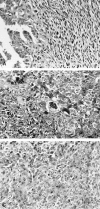Insular and anaplastic carcinoma of the thyroid: a 45-year comparative study at a single institution and a review of the significance of p53 and p21
- PMID: 10714625
- PMCID: PMC1421003
- DOI: 10.1097/00000658-200003000-00005
Insular and anaplastic carcinoma of the thyroid: a 45-year comparative study at a single institution and a review of the significance of p53 and p21
Abstract
Objective: To analyze the clinicopathologic features of a large cohort of patients with insular or anaplastic carcinomas treated at a single institution.
Summary background data: Insular and anaplastic carcinomas of the thyroid, although uncommon, have more aggressive clinical behavior than well-differentiated carcinomas of the thyroid. In the literature, the incidence and features of these carcinomas have not been fully characterized.
Methods: The authors reclassified 740 primary thyroid carcinomas diagnosed and treated between January 1, 1954, and December 30, 1998, to select those with features that met the histologic criteria of insular or anaplastic carcinoma. The clinicopathologic features of these carcinomas were studied and compared. The expression of p53 and p21 in these tumors was analyzed by immunohistochemistry.
Results: Twenty-two patients (5 men, 17 women) with insular carcinoma and 38 patients (7 men, 31 women) with anaplastic carcinoma were found. Patients with insular carcinomas were younger (mean age 45 vs. 70 years) and had smaller tumors than those with anaplastic carcinomas (mean diameter 5 vs. 8 cm). Insular carcinomas were commonly mislabeled as other histologic subtypes, whereas anaplastic carcinomas might be overdiagnosed on pathologic examination. A history of longstanding goiter (>10 years) was noted in 27% of patients with insular carcinoma and 24% of patients with anaplastic carcinomas. Concomitant well-differentiated carcinomas of the thyroid were noted in 59% of patients with insular carcinoma and 39% of patients with anaplastic carcinoma. In anaplastic carcinomas, 13% of patients had concomitant insular carcinoma. Calcification or bone was noted in the stroma of 23% of patients with insular carcinomas and 47% of those with anaplastic carcinomas. The 10-year survival rates for patients with insular carcinoma and anaplastic carcinoma were 42% and 3%, respectively. Distant metastases were seen in 32% of patients with insular carcinoma and in 47% of patients with anaplastic carcinomas. In both types of carcinomas, metastatic tumors were often seen in bone and lung. Distant metastases were noted in a variety of organs in anaplastic carcinomas. In insular carcinoma, neither p53 nor p21 expression was present. In anaplastic carcinoma, p53 and p21 expression was identified in 69% and 3%, respectively. Concomitant expression of p53 and p21 was noted in one tumor.
Conclusions: Insular carcinoma and anaplastic carcinoma had distinctive clinicopathologic features, and recognition of these histologic variants is important for better management of these tumors in the future. p53 overexpression might have a role in dedifferentiation from insular carcinoma to anaplastic carcinoma.
Figures






References
-
- Carcangiu ML, Zampi G, Rosai J. Poorly differentiated (“insular”) thyroid carcinoma. A reinterpretation of Langhans’ “wuchernde Struma.” Am J Surg Pathol 1984; 8:655–668. - PubMed
-
- Flynn SD, Forman BH, Stewart AF, Kinder BK. Poorly differentiated (“insular”) carcinoma of the thyroid gland: an aggressive subset of differentiated thyroid neoplasms. Surgery 1988; 104:963–970. - PubMed
-
- Killeen RM, Barnes L, Watson CG, et al. Poorly differentiated (“insular”) thyroid carcinoma. Report of two cases and review of the literature. Arch Otolaryngol Head Neck Surg 1990; 116:1082–1086. - PubMed
-
- Justin EP, Seabold JE, Robinson RA, et al. Insular carcinoma: a distinct thyroid carcinoma with associated iodine-131 localization. J Nucl Med 1991; 32:1358–63. - PubMed
-
- Papotti M, Botto-Micca F, Favero A, et al. Poorly differentiated thyroid carcinomas with primordial cell component: a group of aggressive lesions sharing insular, trabecular, and solid patterns. Am J Surg Pathol 1993; 17:291–301. - PubMed
Publication types
MeSH terms
Substances
LinkOut - more resources
Full Text Sources
Medical
Research Materials
Miscellaneous

